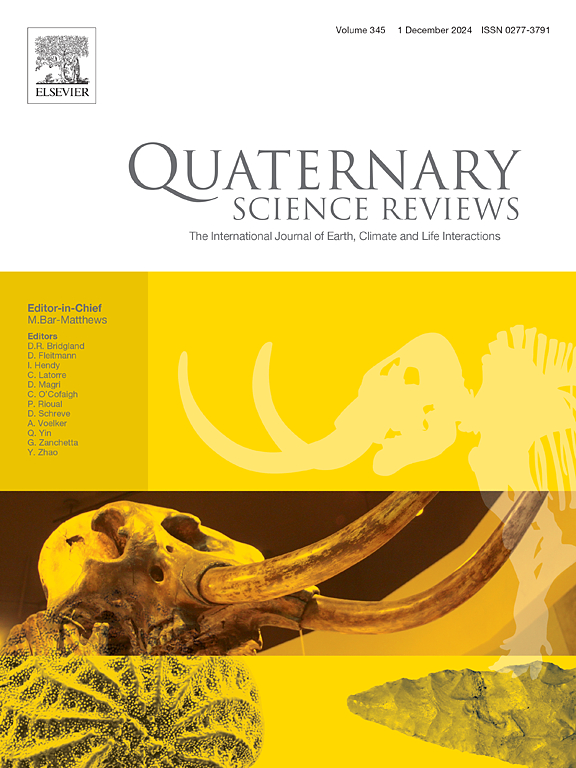Response of Alpine cave glaciation to millennial-scale climate variability during the last glacial period
IF 3.2
1区 地球科学
Q1 GEOGRAPHY, PHYSICAL
引用次数: 0
Abstract
This study examines the response of Alpine cave glaciation to millennial-scale climate variability during the last glacial period, using cryogenic cave carbonates (CCC) as a paleoenvironmental archive. Focusing on the isolated homothermic Hochkogeltunnel gallery in Eisriesenwelt, a large cave in the Austrian Alps, we analyzed coarse-grained CCC (CCC-c) to reconstruct past cave temperatures and ice presence. 230Th dating reveals nine distinct phases of CCC-c formation over a period of 67 ka (77.9 ± 0.5 to 11.2 ± 0.5 ka BP), with most occurrences aligning with interstadial warming events recorded in Greenland ice cores and Alpine stalagmites. Thermal modeling suggests that rapid temperature increases during interstadials warmed this cave gallery to about −1 to 0 °C—the critical range of CCC formation—within approximately 56 yr–131 yr and remained at this temperature for about half a century. Since the model accounts only for conductive heat transfer, this represents a maximum time estimate, yet remains within the uncertainty of the 230Th ages. Our findings confirm that karst hydrology and cave microclimate and thus perennial cave ice responded sensitively to glacial-age climate fluctuations, highlighting the value of CCC-c as a high-resolution archive for past subsurface temperature variability.
末次冰期高山溶洞冰川对千年尺度气候变率的响应
利用低温洞穴碳酸盐(CCC)作为古环境档案,研究了末次冰期高寒洞穴冰川对千年尺度气候变率的响应。以奥地利阿尔卑斯山脉的大洞穴Eisriesenwelt中孤立的恒温Hochkogeltunnel画廊为研究对象,我们分析了粗粒度CCC (CCC-c),以重建过去的洞穴温度和冰的存在。230年代测定显示,在67ka(77.9±0.5 ~ 11.2±0.5 ka BP)的时间内,CCC-c的形成有9个不同的阶段,其中大部分与格陵兰冰芯和阿尔卑斯石笋记录的期间变暖事件一致。热模拟表明,间断期温度的快速升高使该洞廊在大约56 - 131年间升温至- 1 - 0°c (CCC形成的临界范围),并在该温度下保持了大约半个世纪。由于该模型仅考虑传导性热传递,因此这代表了最大时间估计,但仍在230年代的不确定性范围内。我们的研究结果证实了喀斯特水文和洞穴小气候以及多年性洞穴冰对冰川时代气候波动的敏感响应,突出了CCC-c作为过去地下温度变化的高分辨率档案的价值。
本文章由计算机程序翻译,如有差异,请以英文原文为准。
求助全文
约1分钟内获得全文
求助全文
来源期刊

Quaternary Science Reviews
地学-地球科学综合
CiteScore
7.50
自引率
15.00%
发文量
388
审稿时长
3 months
期刊介绍:
Quaternary Science Reviews caters for all aspects of Quaternary science, and includes, for example, geology, geomorphology, geography, archaeology, soil science, palaeobotany, palaeontology, palaeoclimatology and the full range of applicable dating methods. The dividing line between what constitutes the review paper and one which contains new original data is not easy to establish, so QSR also publishes papers with new data especially if these perform a review function. All the Quaternary sciences are changing rapidly and subject to re-evaluation as the pace of discovery quickens; thus the diverse but comprehensive role of Quaternary Science Reviews keeps readers abreast of the wider issues relating to new developments in the field.
 求助内容:
求助内容: 应助结果提醒方式:
应助结果提醒方式:


